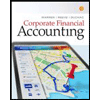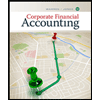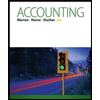
FIN.ACCT-TOOLS F/DECI.MAKERS-TEXT+WILEY+
9th Edition
ISBN: 9781119598312
Author: Kimmel
Publisher: WILEY C
expand_more
expand_more
format_list_bulleted
Concept explainers
Question
Chapter 3, Problem 19Q
(a)
To determine
The Recording Process:
The recording process of any accounting transaction starts with analyzing the transaction,
Journalizing the transaction, and Posting them into the relevant account.
To describe: Meaning of a Ledger
(b)
To determine
To describe: The importance of Chart of accounts
Expert Solution & Answer
Want to see the full answer?
Check out a sample textbook solution
Students have asked these similar questions
General accounting question
Can you help me solve this general accounting problem with the correct methodology?
compute the accrued interest ....???
Chapter 3 Solutions
FIN.ACCT-TOOLS F/DECI.MAKERS-TEXT+WILEY+
Ch. 3 - Prob. 1QCh. 3 - Can a business enter into a transaction that...Ch. 3 - Are the followingevents recorded in the accounting...Ch. 3 - Prob. 4QCh. 3 - Prob. 5QCh. 3 - Prob. 6QCh. 3 - Prob. 7QCh. 3 - Misty Reno, a beginning accounting student,...Ch. 3 - Prob. 9QCh. 3 - What is the normal balance for each of these...
Ch. 3 - Prob. 11QCh. 3 - Prob. 12QCh. 3 - Prob. 13QCh. 3 - Prob. 14QCh. 3 - Prob. 15QCh. 3 - (a) When entering a transaction in the journal,...Ch. 3 - (a) Should accounting transaction debits and...Ch. 3 - Journalize these accounting transactions. (a)...Ch. 3 - Prob. 19QCh. 3 - Prob. 20QCh. 3 - Prob. 21QCh. 3 - Prob. 22QCh. 3 - Prob. 3.1BECh. 3 - For each of the following accounts, indicate the...Ch. 3 - Prob. 3.6BECh. 3 - Prob. 3.7BECh. 3 - Prob. 3.9BECh. 3 - Tilton Corporation has the following transactions...Ch. 3 - Prob. 3.11BECh. 3 - Selected transactions for Montes Company are...Ch. 3 - Prob. 3.1DIECh. 3 - Prob. 3.2DIECh. 3 - Prob. 3.3DIECh. 3 - Prob. 3.4DIECh. 3 - Prob. 3.1ECh. 3 - Prob. 3.6ECh. 3 - Prob. 3.7ECh. 3 - Prob. 3.8ECh. 3 - Prob. 3.9ECh. 3 - Prob. 3.10ECh. 3 - Prob. 3.11ECh. 3 - Prob. 3.12ECh. 3 - Prob. 3.15ECh. 3 - Prob. 3.20ECh. 3 - Prob. 3.23ECh. 3 - Prob. 3.1APCh. 3 - Prob. 3.4APCh. 3 - Prob. 3.11APCh. 3 - Prob. 3.2EYCTCh. 3 - Prob. 3.3EYCTCh. 3 - Prob. 3.4EYCTCh. 3 - Prob. 3.7EYCTCh. 3 - Prob. 3.8EYCTCh. 3 - Prob. 3.9EYCTCh. 3 - Prob. 3.11EYCTCh. 3 - Prob. 3.1IFRS
Knowledge Booster
Learn more about
Need a deep-dive on the concept behind this application? Look no further. Learn more about this topic, accounting and related others by exploring similar questions and additional content below.Similar questions
- Please provide the solution to this financial accounting question using proper accounting principles.arrow_forwardBelow is information for Blue Company. Using this information, answer the following questions on the "Calculation" tab in the file. Show your work (how you got your answer) and format appropriately. Blue company has prepared the following contribution format income statement based on a sales volume of 1,000 units (the relevant range of production is 500 to 1,500 units): Sales $ 40,000 Variable expenses 24,000 Contribution margin 16,000 NOTE: Use the amounts in the original fact pattern to the left as your basis for the questions below. Fixed expenses 12,000 Net operating income $ 4,000 Questions: 1. What is the contribution margin per unit? 2. What is the contribution margin ratio? 3. What is…arrow_forwardI am looking for help with this financial accounting question using proper accounting standards.arrow_forward
- General accountingarrow_forwardPlease explain the correct approach for solving this general accounting question.arrow_forwardRobin Corporation has ordinary income from operations of $30,000, net long-term capital gain of $10,000, and net short-term capital loss of $15,000. What is the taxable income for 2010? a) $25,000. b) $27,000. c) $28,500. d) $30,000. e) None of the above.arrow_forward
- Please explain the solution to this financial accounting problem using the correct financial principles.arrow_forwardI need the correct answer to this financial accounting problem using the standard accounting approach.arrow_forwardI am trying to find the accurate solution to this general accounting problem with the correct explanation.arrow_forward
arrow_back_ios
SEE MORE QUESTIONS
arrow_forward_ios
Recommended textbooks for you
 Financial AccountingAccountingISBN:9781337272124Author:Carl Warren, James M. Reeve, Jonathan DuchacPublisher:Cengage Learning
Financial AccountingAccountingISBN:9781337272124Author:Carl Warren, James M. Reeve, Jonathan DuchacPublisher:Cengage Learning Corporate Financial AccountingAccountingISBN:9781305653535Author:Carl Warren, James M. Reeve, Jonathan DuchacPublisher:Cengage Learning
Corporate Financial AccountingAccountingISBN:9781305653535Author:Carl Warren, James M. Reeve, Jonathan DuchacPublisher:Cengage Learning Corporate Financial AccountingAccountingISBN:9781337398169Author:Carl Warren, Jeff JonesPublisher:Cengage Learning
Corporate Financial AccountingAccountingISBN:9781337398169Author:Carl Warren, Jeff JonesPublisher:Cengage Learning AccountingAccountingISBN:9781337272094Author:WARREN, Carl S., Reeve, James M., Duchac, Jonathan E.Publisher:Cengage Learning,
AccountingAccountingISBN:9781337272094Author:WARREN, Carl S., Reeve, James M., Duchac, Jonathan E.Publisher:Cengage Learning, Accounting (Text Only)AccountingISBN:9781285743615Author:Carl Warren, James M. Reeve, Jonathan DuchacPublisher:Cengage LearningPrinciples of Accounting Volume 1AccountingISBN:9781947172685Author:OpenStaxPublisher:OpenStax College
Accounting (Text Only)AccountingISBN:9781285743615Author:Carl Warren, James M. Reeve, Jonathan DuchacPublisher:Cengage LearningPrinciples of Accounting Volume 1AccountingISBN:9781947172685Author:OpenStaxPublisher:OpenStax College

Financial Accounting
Accounting
ISBN:9781337272124
Author:Carl Warren, James M. Reeve, Jonathan Duchac
Publisher:Cengage Learning

Corporate Financial Accounting
Accounting
ISBN:9781305653535
Author:Carl Warren, James M. Reeve, Jonathan Duchac
Publisher:Cengage Learning

Corporate Financial Accounting
Accounting
ISBN:9781337398169
Author:Carl Warren, Jeff Jones
Publisher:Cengage Learning

Accounting
Accounting
ISBN:9781337272094
Author:WARREN, Carl S., Reeve, James M., Duchac, Jonathan E.
Publisher:Cengage Learning,

Accounting (Text Only)
Accounting
ISBN:9781285743615
Author:Carl Warren, James M. Reeve, Jonathan Duchac
Publisher:Cengage Learning

Principles of Accounting Volume 1
Accounting
ISBN:9781947172685
Author:OpenStax
Publisher:OpenStax College
ACCOUNTING BASICS: Debits and Credits Explained; Author: Accounting Stuff;https://www.youtube.com/watch?v=VhwZ9t2b3Zk;License: Standard Youtube License